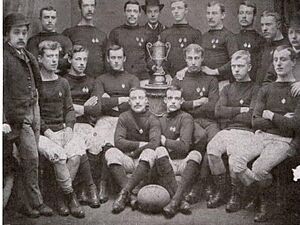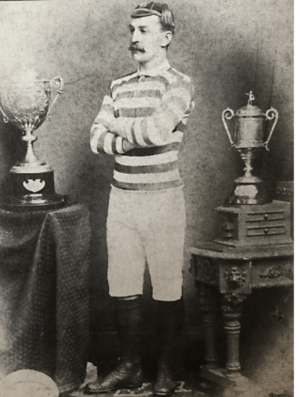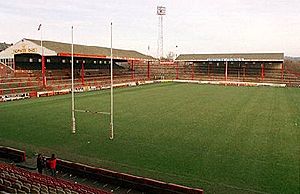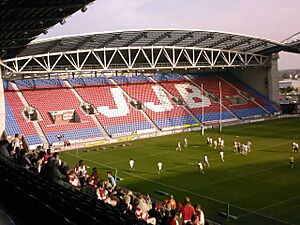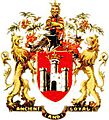History of the Wigan Warriors facts for kids
The History of the Wigan Warriors goes all the way back to when the club was started in 1872. Wigan was one of the first teams to join the Northern Rugby Football Union in 1895. This happened after a big split from the original rugby football game. Today, Wigan is the most successful club in British Rugby League history. They have won more trophies than any other team! This includes 22 Rugby Football League Championships (with 5 Super League Grand Final wins), 20 Challenge Cups, and 4 World Club Challenge trophies.
Wigan had an amazing time from the 1980s to the mid-1990s. They won the Challenge Cup eight years in a row and the League Championship seven years in a row! During this golden age, they also won many other cups. The club has a special Hall of Fame to remember its best players. Some famous players in the Hall of Fame are Billy Boston, Ellery Hanley, Dean Bell, and Shaun Edwards.
Contents
Starting the Club: The Early Years
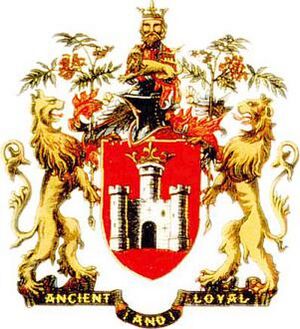
On November 21, 1872, the Wigan Football Club was formed. Members of the Wigan Cricket Club started it at a meeting in the Royal Hotel. The team played their first games at Folly Field. Their very first official match was on January 18, 1873, in Warrington. It ended in a draw.
A few years later, in 1876, the club faced money problems. Many players from Upholland F.C. joined, and the club changed its name to Wigan & District F.C. They moved their home games to the Wigan Cricket Club ground. However, the club struggled and seemed to stop playing by 1879.
The Wigan Wasps and First Trophies
On September 22, 1879, the club was restarted as Wigan Wasps. Some original members and many new ones met to bring the club back. They moved back to Folly Field. In 1883, Wigan won its first trophy, the Wigan Charity Cup. They also won the West Lancashire Cup in 1884 and the Wigan Union Charity Cup in 1885.
A big change happened on September 26, 1885. For the first time, the team wore their famous cherry and white jerseys! In 1888, the club even hosted the touring New Zealand Maoris team.
The Big Split in Rugby
Wigan got into trouble with the RFU. The RFU had strict rules about players not getting paid. Wigan argued that their working-class players needed some money to cover lost wages. Because of this, in 1895, Wigan joined other clubs from Yorkshire and Lancashire. They formed the Northern Union, which led to the sport of rugby league. This was a major split from the old rugby union rules. After this, the "Wasps" name was dropped, and the club became simply known as Wigan.
Wigan's first game in the new Northern Union was on September 7, 1895, against Broughton Rangers. Here were the players that day:
- Billy Benson, forward
- Jack Blackburn, forward
- Jack Brown, forward
- Frank Dixon, half back
- Billy Halliwell, half back
- Percy Jago, three-quarter back
- J. Perkins, forward
- E. Railton, three-quarter back
- George Rigby, forward
- Johnny Roberts, three-quarter back
- Billy Unsworth, forward
- Jimmy Walkden, three-quarter back
- E. Webster, forward
- John Winstanley, full back
- Bill Yates, forward
In 1896–97, the Northern League was replaced by two County Senior leagues because there were so many teams. The Northern Union Cup, later called the Rugby League Cup, was also introduced. Wigan made it to the third round before being knocked out.
The Early 1900s: New Homes and First Cups
In 1901, Wigan moved to Springfield Park. They shared this ground with Wigan United AFC, a soccer team. Their first game there was on September 14, 1901, where 4,000 fans watched Wigan beat Morecambe 12–0. That season, Wigan won the Lancashire Senior Competition. The biggest crowd at Springfield Park was 10,000 in March 1902.
Moving to Central Park
On September 6, 1902, Wigan played at Central Park for the first time. This was the opening match of the new First Division. About 9,000 fans saw Wigan beat Batley 14–8. Central Park would be their home for many years.
In the 1905–06 season, the club won its first rugby league cup, the Lancashire County Cup. Between 1906 and 1923, Wigan won the Lancashire League seven times and the Lancashire Cup four times. They were the first team to win the Lancashire Cup.
Wigan played against the New Zealand team on November 9, 1907, and won 12–8 in front of about 30,000 people. On October 28, 1911, Wigan also beat the touring Australasian team.
Jim Sullivan: A Legend Arrives
In June 1922, a young 17-year-old named Jim Sullivan joined Wigan. He was a huge signing, costing £750, which was a lot of money for a teenager who hadn't played rugby league before. His first game was on August 27, 1921, and he scored ten points in a 21–0 win.
Sullivan scored the first points in the first ever Challenge Cup Final played at Wembley Stadium in 1929. He kicked a penalty after three minutes, helping Wigan win 13–2 against Dewsbury. Sullivan later became the player-coach in 1932.
Wigan won its first Challenge Cup in the 1923–24 season. They beat Oldham 21–4. In 1933, the Prince of Wales visited Central Park. He was the first royal to ever watch a rugby league match!
World War II caused some changes to the league, but Wigan kept playing in the Lancashire War League. They even went unbeaten in the 1940–41 season, though they lost the Championship final. In 1944, they lost the Challenge Cup Final but then beat Dewsbury to win the Championship Final.
Mid-1900s: Televised Games and More Stars
Jim Sullivan played his last game as a player in February 1946. He stayed on as coach for six more seasons.
In 1948, Wigan played in the first ever rugby league match shown on television! It was their 8–3 Challenge Cup Final win over Bradford Northern. This was also the first time a king, King George VI, watched a rugby league match and presented the trophy.
On October 27, 1951, a massive crowd of 33,230 fans saw Wigan beat Leigh 14–6 in the Lancashire Cup final. In 1952, Wigan won their sixth Lancashire Cup in a row! Wigan also played in the first league match ever shown on TV, against Wakefield Trinity in January 1952.
The Boston and Ashton Era
In 1953, Wigan signed Billy Boston for £150. He became one of Wigan's most famous and successful players. Eric Ashton also joined Wigan for £150 in 1955. During the time Boston and Ashton played, Wigan went to Wembley six times and won three Challenge Cups.
The biggest crowd ever at Central Park was 47,747 on March 27, 1959, when Wigan played St. Helens. Wigan won that exciting game 19–14.
Joe Egan coached Wigan from 1958 to 1961. Under him, the club won the Championship final in 1960 and the Challenge Cup in 1958 and 1959. Eric Ashton then coached Wigan from 1963 to 1973. In 1966, Wigan famously blocked TV cameras from their ground, believing it hurt attendance. They were fined £500 for this. Billy Boston played his last game for Wigan in April 1968.
Wigan had a lot of success until 1974. After that, they went eight seasons without winning any major leagues or cups.
Late 1900s: A New Golden Age
In November 1972, Wigan celebrated its 100th birthday with a match against Australia. The game ended in an 18–18 draw. In October 1973, Wigan had a surprise 19–9 victory over Salford in the Lancashire Cup Final.
The club went through several coaches in the 1970s, with many lasting only a season or two. In 1980, Wigan was relegated from the top league for the only time in their history. However, they quickly won promotion back the next season.
The Start of Dominance
Maurice Lindsay joined Wigan's directors in the early 1980s. Under coach Alex Murphy, Wigan won their first John Player Trophy in January 1983. The next season, they reached the Wembley Challenge Cup final but lost.
In 1985, Wigan returned to Wembley and won the Challenge Cup! They beat Hull 28–24 in one of the most exciting finals ever. Brett Kenny was named man of the match.
Big new players like Ellery Hanley and Joe Lydon joined in 1985-86. Wigan then hired former New Zealand coach Graham Lowe. Between February and October 1987, Wigan won a record 29 games in a row! They won the First Division Championship and beat the Australian team, Manly-Warringah, 8–2 in an unofficial World Club Championship. This was the first time an English team beat an Australian team since 1978.
The Unstoppable Years
From 1988 to 1995, Wigan had their most successful period ever. They won the Challenge Cup eight seasons in a row! They also won the Championship seven times, the John Player/Regal Trophy four times, and three World Club Championships.
In 1996, Wigan played a special two-match series against Bath RFC. One game was played under rugby league rules, and Wigan won 82–6. The other was under rugby union rules, and Wigan lost 44–19. In July 1996, Andy Farrell became the Wigan club's captain.
In 1997, the club changed its name to Wigan Warriors. The new professional league and salary cap rules made it harder for Wigan to dominate. In 1998, Wigan reached the Challenge Cup final again. They were favorites, but Sheffield Eagles caused a huge upset, winning 17–8.
However, Wigan still won the Minor Premiership and the first ever Super League Grand Final in 1998, beating Leeds Rhinos 10–4.
Moving to a New Home
In 1999, after not winning a trophy for the first time in 15 years, coach Andy Goodway was sacked. Dave Whelan bought the club, and both the Warriors and the town's soccer team, Wigan Athletic, moved to the JJB Stadium.
Wigan's last game at Central Park was against their rivals St Helens on September 5, 1999. Wigan won 28–20. Their first game at the new stadium was a loss to Castleford Tigers on September 19, 1999.
The 2000s and Beyond
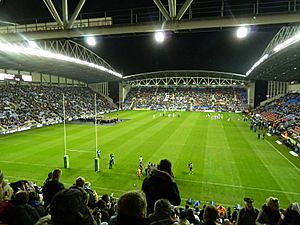
Frank Endacott became head coach after the 1999 season but was sacked in 2001. In 2000, Wigan finished top of the Super League but lost the Grand Final to St Helens. They reached the Grand Final again in 2001 but lost to Bradford Bulls. That year, Andy Farrell set a new club record with 429 points in a season.
In 2002, Wigan won their 17th Challenge Cup, beating St Helens 21–12. Coach Stuart Raper was sacked in 2003. He was replaced by Mike Gregory, who led the team to the Grand Final, where they lost to Bradford Bulls. In 2004, Gregory guided Wigan to the Challenge Cup final again, but they lost to St Helens. This was his last match as coach due to illness.
Wigan faced tough times in the mid-2000s, including problems with the salary cap. They were fined and lost points for spending too much. In 2006, Wigan was at the bottom of the league and risked being relegated. Coach Ian Millward was sacked and replaced by Brian Noble. Wigan avoided relegation that year.
In 2007, Ian Lenagan bought the club from Dave Whelan, promising a new era for the Warriors. Wigan reached the Challenge Cup Semi-Final and the Super League play-offs in 2007 and 2008, but lost to Catalans Dragons and Leeds Rhinos respectively.
A New Era of Success
In 2009, Wigan became a charity, which helps them get extra money to support rugby league activities for young people. They reached the Challenge Cup Semi-Final again but lost. After this, coach Brian Noble left.
Michael Maguire became the new Head Coach in October 2009. In 2010, under Maguire, Wigan had a fantastic season. They finished top of the Super League table and won three trophies: the Floodlit 9s, the League Leaders Shield, and the Super League Grand Final! On October 2, they beat St. Helens 22–10 in the Grand Final, their first win since 1998.
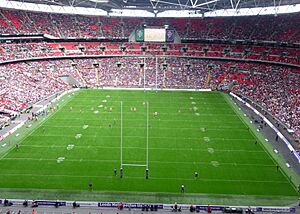
Wigan also won many awards that year, including Young Player of the Year for Sam Tomkins, Coach of the Year for Michael Maguire, and Man of Steel for Pat Richards. The club was named Club of the Year.
On August 27, 2011, Wigan Warriors won the Challenge Cup final against Leeds Rhinos at Wembley Stadium, with a score of 28–18. This was Wigan's first visit to Wembley in 13 years!
Team Colours, Kits, and Sponsors
For a long time, Wigan played in blue and white striped jerseys. But in 1886, they switched to the famous cherry and white hoops that everyone knows today. Since then, their home kits have always been cherry and white, usually with hoops. Sometimes the red has been a lighter shade, but the club is always known as "the Cherry and Whites."
Their away kits are usually blue and white, possibly because those were their original colours. These away kits have been different shades of blue and different designs. There have been a few exceptions, like a black and white kit in 2001 and a black kit with red trim in 2007.
Wigan has had a few main shirt sponsors over the years. JJB Sports was the first in 1981. Then Norweb sponsored them from 1989 to 1998. After that, Energi (part of Norweb) took over. In 2000, JJB Sports became the sponsor again, as Dave Whelan, who owned JJB Sports, also owned the club. JJB Sports remained the sponsor even after Whelan sold the club. In 2009, Meccabingo.com became the new sponsor.
Different companies have made Wigan's kits, including Umbro, Puma, Adidas, and Nike. For a while, the kit maker was linked to JJB Sports. In 2008, Wigan signed a big three-year deal with KooGa.
In November 2008, Wigan released a special limited edition shirt, with some of the money from each sale going to a local hospice. The 2009 home kit went back to the traditional cherry red and white hoops. The away shirt was blue with a white semi-hoop. The 2010 home kit continued the cherry and white hoops, while the away kit was mainly black with silver. The 2011 home kit had a new design with shaded cherry-to-white hoops and white flashes.
In December 2009, the club opened a shop in the Grand Arcade in Wigan to sell merchandise.
Home Grounds: Where Wigan Played
Wigan Football Club played its first match at Folly Field in 1872 and stayed there for four years. After a club change, they played at Prescott Street. When the club reformed as Wigan Wasps, they returned to Folly Field before moving back to Prescott Street in 1886.
Wigan played at Wigan Cricket Club on Prescott Street until 1901. Then they moved to Springfield Park, sharing it with Wigan United A.F.C. The first rugby match there was on September 14, 1901.
In 1902, Wigan moved to a stadium built just for them, Central Park. Their first game there was on September 6, 1902. Central Park was the club's home until 1999. The very last match at Central Park was against St Helens on September 5, 1999, which Wigan won 28–20 in front of 18,179 fans.
Today, Wigan plays home games at the 25,000-seat DW Stadium (which used to be called the JJB Stadium). This stadium is shared with Wigan Athletic Football Club. The rugby club has a 50-year lease on the stadium, so they can keep using it for a long time.
Wigan Warriors: A History of Trophies
Wigan Warriors are known for winning many trophies throughout their long history. They have won the top league championship 22 times, including 5 Super League Grand Finals. They have also lifted the Challenge Cup an amazing 20 times. On top of that, they have won the World Club Challenge 4 times, proving they are among the best teams in the world.
During their most successful period from the 1980s to the mid-1990s, Wigan won the Challenge Cup eight years in a row and the League Championship seven years in a row. They also won many other domestic cups, showing their incredible dominance in British rugby league.
Images for kids


